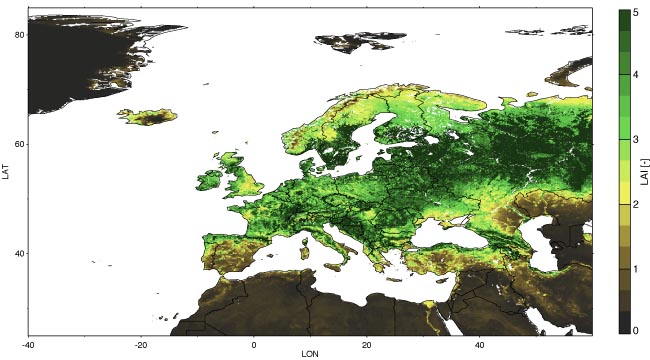 The EFAI NDVI is a high resolution land surface parameter dataset for climate modeling and mesoscale weather simulations. It was derived from the 20 year long NASA/NOAA AVHRR Pathfinder NDVI dataset, which is available in 10 day temporal and 0.1 degree spatial resolution for global area coverage.
The EFAI NDVI is a high resolution land surface parameter dataset for climate modeling and mesoscale weather simulations. It was derived from the 20 year long NASA/NOAA AVHRR Pathfinder NDVI dataset, which is available in 10 day temporal and 0.1 degree spatial resolution for global area coverage.
The variability of vegetation state and function motivates the creation of high-resolution vegetation parameters varying dynamically over space and time. These parameters can be used to model the complex soil-vegetation-atmosphere interactions but also to assess the long-term changes in land use and vegetation physiology over a large area. The knowledge of the temporal variability of vegetation is a key requirement to quantify the carbon pools and exchanges on local and global scale. On global scale, satellite remote sensing now offers the possibility to estimate vegetation phenology with a high spatial and temporal revisiting frequency.
The NOAA/NASA Pathfinder dataset (James and Kalluri 1994) uses the NOAA polar orbiting satellites and is corrected for Rayleigh scattering and ozone absorption as well as for instrument degradation. It is however not corrected for aerosols or viewing geometry effects. High solar zenith angles in high latitudes causes long term data dropouts during winter. The cloud screening is problematic and leads to temporal inconsistencies in the original Pathfinder dataset. To create a spatio-temporally consistent vegetation phenology useful for climate research we used the Pathfinder NDVI (Normalized Difference Vegetation Index) over Europe and applied the following correction methodology:
- Replacement of processing artifacts and data gaps in the dataset by spatial interpolation
- Adjustment of the NDVI time-series by using a temporal interpolation procedure
The temporal interpolation procedure is a modification of Los (1998) and Sellers et al. (1996) and uses second order discrete fourier series to extract the seasonal variability of vegetation state and function from the Pathfinder NDVI dataset. The resulting spatio-temporally consistent 0.1 degree and 10 day NDVI dataset is called EFAI NDVI (European Fourier-Adjusted and Interpolated NDVI). A full description of this methodology is available in Stöckli and Vidale (2004). Biophysical land surface parameters were derived from the EFAI NDVI by applying simple empirical relationships between satellite radiometry and vegetation physiology.
The EFAI Dataset has also been processed at global scale and is available here. It has been superseded by higher quality and better gap-filled products. For instance our NASA Energy and Water Cycle MODIS-based FPAR/LAI data assimilation project called Pheno Analysis is a suitable successor of the EFAI NDVI.
Reference: R. Stöckli and P. L. Vidale (2004). European plant phenology and climate as seen in a 20-year avhrr land-surface parameter dataset, International Journal of Remote Sensing, 25(17), 3303–3330

